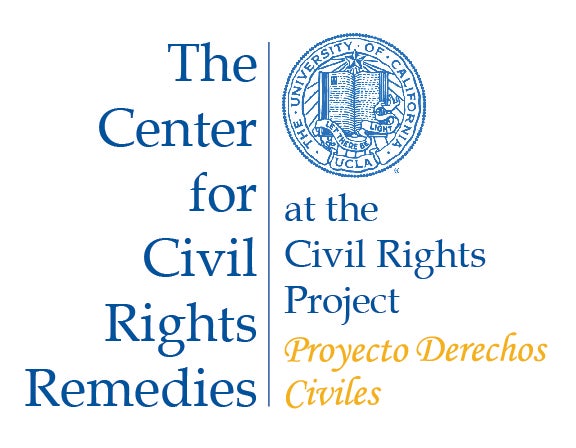WASHINGTON, D.C. – Today, the Center for Civil Rights Remedies at the UCLA Civil Rights Project is releasing first-of-their-kind reports that shed light on the growing use of punitive disciplinary measures and provides research-based alternatives. The reports were presented at a Congressional briefing by researchers with responses from the legislative staffers and civil and disability rights advocates on Capitol Hill earlier today.
The first report, “Out of School & Off Track: The Overuse of Suspensions in American Middle and High Schools,” written by Daniel J. Losen and Tia Elena Martinez, uses U.S. Department of Education data on over 26,000 U.S. middle and high schools to reveal disturbing racial disparities and the increased use of suspensions. The report provides detailed data featuring 20 localities from across the nation, and it disaggregates suspension rates in secondary schools by race, gender, English learner and disability status. This unprecedented depth of research has found that well over two million students, or one in nine, were suspended during the 2009-2010 academic year. There were many other troubling findings, such as 36% of all Black male students with disabilities enrolled in middle and high schools in the data set were suspended at least once in 2009-2010. These findings are of serious concern given that research shows being suspended even once in ninth grade is associated with a 32% risk for dropping out, double that for those receiving no suspensions.
“We now see that across the nation, one in four Black students and one in five students with disabilities and English Learners are suspended,” said Daniel Losen, report author and director of The Center for Civil Rights Remedies. “There is something terribly wrong when, despite very effective alternatives, so many middle and high schools quickly punish and exclude students of color, students with disabilities and English Learners. We know these schools can change because in many large districts, we found many low-suspending schools where suspension is still a measure of last resort.”
The report’s comprehensive district and school level “hot spot” analysis shows that often in districts with many high suspending “hot spot” schools, where 25% or more of students are suspended, there are numerous low-suspending secondary schools, where no group is suspended above 10%. In other words, in many districts, some proven effective alternatives are already in place.
The second report refers to a research summary and 16 research papers presented at the conference, “Closing the School Discipline Gap: Research to Practice,” which highlights new research from leading scholars across the nation. These papers describe the reasons for the race/ethnicity gaps, and how reducing the unfair use of suspensions can help improve graduation rates, achievement scores and life outcomes, while also decreasing the incarceration rate for juveniles and adults. Several studies spell out effective alternatives to out of school suspension in places like Cleveland, Ohio and across the state of Virginia. Together, these 16 new studies debunk the myth that punitive disciplinary measures are needed to ensure safe and productive school climates. The research provides examples of interventions that schools can pursue, such as teacher training programs, restorative justice, and social and emotional learning strategies, that will pay dividends in reduced racial disparities in disciplinary exclusion, increased engagement and reduced dropout rates for all children.
“Although we often assume that these are problems of poor students behaving badly, these findings show that school practices actually play a stronger role in creating and maintaining racial disparities in discipline,” said Russ Skiba, at the Equity Project at Indiana University and Director of the national Race and Gender Disparities Collaborative. “That means that schools can make a difference in reducing these gaps, through improved relationships, more effective discipline programs, and culturally responsive instruction and management.”
The Reports’ Recommendations are concrete and detailed. For instance:
Data and Monitoring: Parents, especially of children of color, students with disabilities and English learners, should exercise their right to know which secondary schools are suspending their children in high and disproportionate numbers. States and districts should annually collect and publicly report discipline data and disaggregate the information for elementary and secondary levels by race/ethnicity, gender, disability status and English learner status.
Accountability: Federal and state education accountability systems should make discipline a core component of school and district evaluation. Moreover, districts should use discipline data as early warning signs that students, and even entire schools, are falling off the track toward graduation.
Support and Training for What Works: Federal, state, and district policy makers should provide funds and incentives for schools and districts to provide training in classroom and behavior management for teachers, especially for teachers of adolescent youth; and similarly encourage schools and districts to adopt alternative evidence-based positive behavioral strategies.
Both reports provide additional detailed, research-based recommendations for policy and practice to educators, parents, advocates, federal and state policymakers, and the media.
The two reports, along with detailed profiles for 20 localities and spreadsheets giving detailed discipline data for over 6,000 school districts across the country, can be found here.
In addition, local profiles were created for the following cities:
1. Jefferson County, AL
2. Los Angeles, CA
3. Atlanta City, GA
4. Fulton City, GA
5. Chicago, IL
6. Worcester, MA
7. St. Paul, MN
8. St. Louis City, MO
9. Woodbridge Township, NJ
10. Syracuse City, NY
11. Yonkers, NY
12. Cumberland County, NC
13. Columbus City, OH
14. Oklahoma City, OK
15. Philadelphia, PA
16. Providence, RI
17. Memphis, TN
18. Dallas, TX
19. Houston ,TX
20. Fairfax, VA
Access the first report here: “Out of School & Off Track: The Overuse of Suspensions in American Middle and High Schools.
